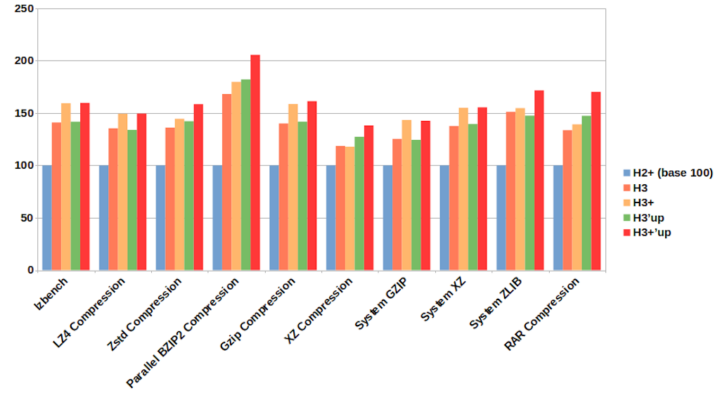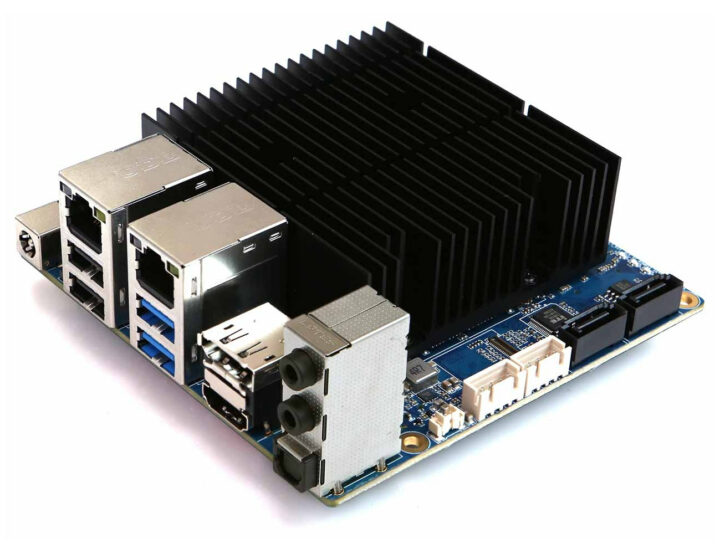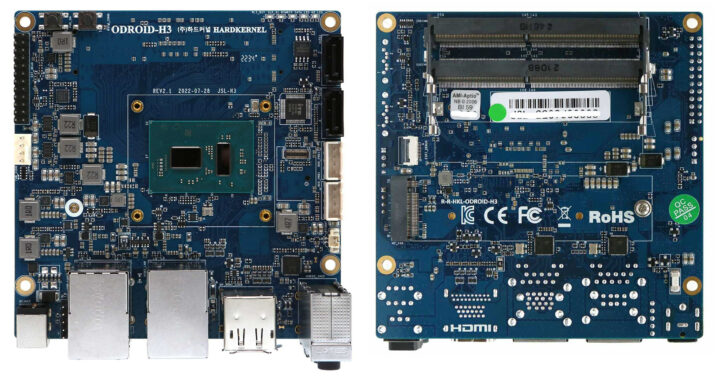There are now not one but two alternatives to the discontinued ODROID-H2+ SBC with the ODROID-H3 and ODROID-H3+ single board computers powered respectively by an Intel Celeron N5105 and Pentium N6005 Jasper Lake processor.
Both new SBCs support up to 64GB RAM, significantly faster Intel UHD graphics, an M.2 PCIe Gen 3 socket, and keep the same port assignment with two 2.5GbE ports, two SATA ports, as well as two USB 3.0 and two US 2.0 ports.
- SoC
- ODROID-H3 – Intel Celeron N5105 quad-core Jasper Lake processor @ 2.0GHz / 2.9GHz (Turbo) with 24EU Intel UHD graphics @ 450 / 800 MHz (Turbo); 10W TDP
- ODROID-H3+ – Intel Pentium N6005 quad-core Jasper Lake processor @ 2.0GHz / 3.3GHz (Turbo) with 32EU Intel UHD graphics @ 450 / 900 MHz (Turbo); 10W TDP
- System Memory – Dual-channel SO-DIMM DDR4 memory (2933MT/s) supporting up to 64GB RAM in total
- Storage – M.2 PCIe Gen 3 x4 slot for one NVMe storage, 2x SATA 3.0 ports, eMMC flash support
- Video Output
- HDMI 2.0 up to 4K (4096×2160) @ 60 Hz
- DisplayPort 1.2 up to 4K (4096×2160) @ 60 Hz
- Audio – HDMI, audio jacks for HP, MIC. and S/PDIF
- Connectivity – Dual 2.5 Gigabit Ethernet (RJ45) via RTL8125B chipset
- USB – 2x USB 3.0 ports, 2x USB 2.0 ports
- Expansion – 24-pin header with 2x I2C, 1x UART (3.3V), 3x USB2.0, HDMI CEC signals, external power button
- Security – fTPM (TPM 2.0) enabled
- Misc – RTC battery (Included), standard 12V PWM fan header as found in PCs
- Power Supply – 14V to 20V DC power input (60W recommended, 133W with two 3.5-inch hard drives)
- Dimensions – 110 x 110mm
Hardkernel also says the new boards support an “Unlimited Performance” mode allowing the CPU to run in sustained turbo boost mode. The fTPM ensures that Windows 11 can run, something that may not be possible on the ODROID-H2+, at least not without tweaks. Of course, any operating system that works on x86 hardware will also run on the new Hardkernal SBCs including Windows, Linux, and BSD operating systems, as well as Android.
The company further explains the CPU base frequency increases by 16% (H3) and 32% (H3+) compared to the H2+, the memory bandwidth by 22%, and the disk I/O increases by 97% thanks to the PCIe Gen3 upgrade from Gen2. They tested over 300+ benchmarks on the boards and noted a performance increase ranging in average from 45% to 73%, and in some cases, the performance more than doubled.

The ODROID-H3 and ODROID-H3 keep compatibility with the ODROID-H2+ so you can reuse the same enclosures, as well as add-on boards such as the H2 Net M.2 card with four 2.5GbE ports. Besides the existing acrylic enclosures, Hardkernel also made more sturdy enclosures using thin and rigid PCB made of glass fiber epoxy with the same designs, and some new designs for a total of 7.

You’ll find more technical details on the Wiki and a forum post about ODROID-H3/H3+ single board computers.
Both boards can be purchased now with the ODROID-H3 SBC going for $129 and the ODROID-H3+ model selling for $165.
Thanks to T for the tip.

Jean-Luc started CNX Software in 2010 as a part-time endeavor, before quitting his job as a software engineering manager, and starting to write daily news, and reviews full time later in 2011.
Support CNX Software! Donate via cryptocurrencies, become a Patron on Patreon, or purchase goods on Amazon or Aliexpress






